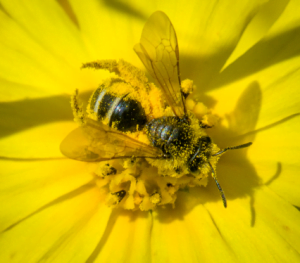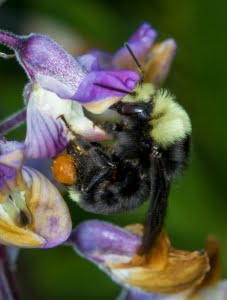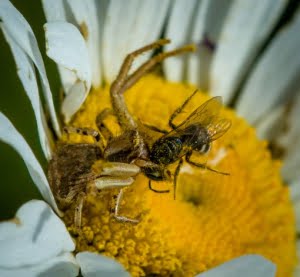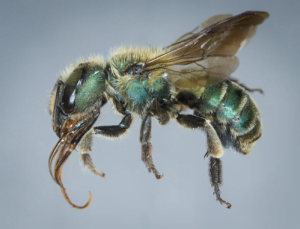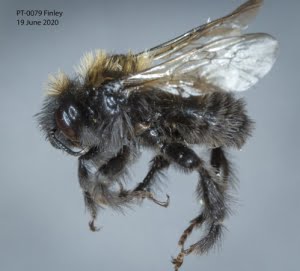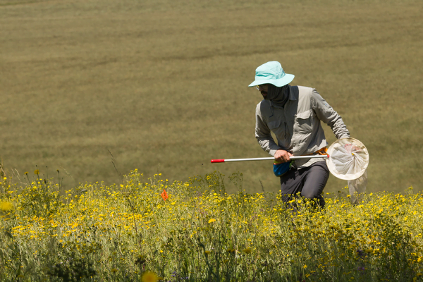
Osmia Out of Nowhere, and Other Pollinator Tales
By David Cappaert, IAE Pollinator Crew
September 2020
We often think of pollination as a discrete event, e.g., the interaction between a sunflower and a bumblebee. But the bee might visit a dozen other pollen sources, and the sunflower might benefit from dozens of pollinator species. If you look at this broader picture, for all of the flower and insect species at each of 15 sites across the Pacific Northwest, you can learn something about how an entire system—a pollination network—is organized. That is the aim of the Prairie Pollinator Project, a collaboration between IAE researchers and Susan Waters of the Center for Natural Lands Management at various sites around the Willamette Valley of Oregon. But for those of us in the field, following all Covid-19 protocols and safely distanced from our colleagues, the excitement is what we see in a meter square in 5 minute increments. Watching a stand of Madia (pictured above), you’ll see Lasioglossum titusi (1), a sweat bee that can barely fly with her pollen load, and many kinds of hoverfly (2). Bumblebees (3) prefer lupine. Occasionally there is a surprise, a motionless pollinator in the jaws of a crab spider (4).
The daily routine also offers the occasional mystery. At one site (Finley National Wildlife Refuge south of Corvallis, Oregon), we tracked pollinators of every flowering plant through June, 2020. We knew all of the common insects, and most of the relatively rare ones. In a parallel study, we set pan traps—small colored cups—to collect large samples of bees, hoping to catch the truly rare species, like Diadasia (5), never previously seen in our studies. Even more unexpected, however: The most common insect in our traps was found to be Osmia or mason bees (6), that were completely absent from our direct observations. This is a delicious mystery, because we had a very complete set of observational data. The Osmia were abundant at Finley, but were never directly seen on any flowering plant. Ridiculous ideas like nocturnal foraging or bee disguises were discarded. A check with our bee experts produced no solid hypothesis. Ultimately, we saw a few Osmia on Clarkia flowers, but the larger mystery of when they forage remains.
We also pursue an overlapping question in this study; to identify the pollination links for the endangered Willamette daisy (Erigeron decumbens). It is humbling to spend time with a species so rare that we have personally seen the majority of plants in existence. We’ve documented a variety of small bees which are the obvious candidates for the role of critical pollinators. But hoverflies (7) are far more abundant. Do they matter to Willamette daisy? That’s another question that our science hasn’t yet answered, and another reason why we squat in lovely meadows counting insects.
"The Corps of Engineers Willamette Valley Project is responsible for the largest remnant population of Willamette daisy. Little is known of the pollination biology of this endangered prairie plant," says Wes Messinger of the U.S. Army Corps of Engineers. "To better maintain and recover the species and its equally endangered prairie habitat, we initiated agreements with IAE and CLNM to study the plant’s pollinators, and how they interact with other plants. We’re excited about how the partners’ efforts across the range of the daisy may inform prairie management, and by all the neat bug biology and ecology we’re finding out!"
IAE is grateful for the partnership of the Center for Natural Lands Management and funding from the Army Corps of Engineers and Bureau of Land Management.
Restoration
Research
Education
Get Involved
Contact
Main Office:
4950 SW Hout Street
Corvallis, OR 97333-9598
541-753-3099
[email protected]
Southwest Office:
1202 Parkway Dr. Suite B
Santa Fe, NM 87507
(505) 490-4910
[email protected]
© 2024 Institute for Applied Ecology | Privacy Policy
